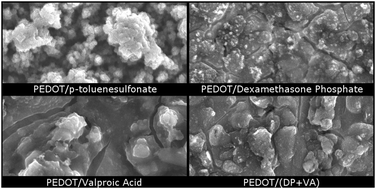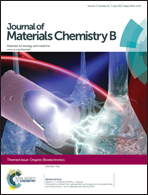Small bioactive molecules as dual functional co-dopants for conducting polymers
Abstract
Biological responses to neural interfacing electrodes can be modulated via biofunctionalisation of conducting polymer (CP) coatings. This study investigated the use of small bioactive molecules with anti-inflammatory properties. Specifically, anionic dexamethasone phosphate (DP) and valproic acid (VA) were used to dope the CP poly(ethylenedioxythiophene) (PEDOT). The impact of DP and VA on material properties was explored both individually and together as a codoped system, compared to the conventional dopant p-toluenesulfonate (pTS). Electrical properties of DP and VA doped PEDOT were reduced in comparison to PEDOT/pTS, however co-doping with both DP and VA was shown to significantly improve the electroactivity of PEDOT in comparison the individually doped coatings. Similarly, while the individually doped PEDOT coatings were mechanically friable, the inclusion of both dopants during electropolymerisation was shown to attenuate this response. In a whole-blood model of inflammation all DP and VA doped CPs retained their bioactivity, causing a significant reduction in levels of the pro-inflammatory cytokine TNF-α. These studies demonstrated that small charged bioactive molecules are able act as dopants for CPs and that co-doping with ions of varied size and doping affinity may provide a means of addressing the limitations of large bulky bimolecular dopants.

- This article is part of the themed collection: Bioelectronics

 Please wait while we load your content...
Please wait while we load your content...